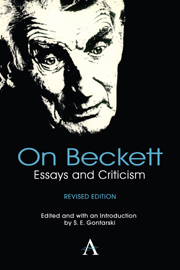Book contents
- Frontmatter
- Contents
- The Essential Beckett: A Preface to the Second Edition
- A Beckett Chronology
- Acknowledgments
- Crritics and Crriticism: “Getting Known”
- Preliminaries
- The Page
- Murphy and the Uses of Repetition
- Watt
- Mercier and Camier: Narration, Dante, and the Couple
- Molloy's Silence
- Where Now? Who Now?
- The Voice and Its Words: How It Is
- The Unnamable's First Voice?
- Between Verse and Prose: Beckett and the New Poetry
- Worstward Ho
- The Stage
- Coda
- Notes on Contributors
Murphy and the Uses of Repetition
from The Page
Published online by Cambridge University Press: 05 May 2013
- Frontmatter
- Contents
- The Essential Beckett: A Preface to the Second Edition
- A Beckett Chronology
- Acknowledgments
- Crritics and Crriticism: “Getting Known”
- Preliminaries
- The Page
- Murphy and the Uses of Repetition
- Watt
- Mercier and Camier: Narration, Dante, and the Couple
- Molloy's Silence
- Where Now? Who Now?
- The Voice and Its Words: How It Is
- The Unnamable's First Voice?
- Between Verse and Prose: Beckett and the New Poetry
- Worstward Ho
- The Stage
- Coda
- Notes on Contributors
Summary
What is right may properly be uttered even twice.
—EmpedoclesMurphy is a novel of great beauty and complexity. These qualities are interrelated: As the work's diverse elements coalesce into a unified pattern, its beauty is revealed. Like More Pricks than Kicks, Murphy contains many recurring elements that are used to illuminate an underlying level of meaning. One's understanding of the work changes after successive readings: Trivial details gain significance, unambiguous statements become mysterious, latent themes emerge. Little of this is immediately apparent, however. In the time since 1938, when Murphy first appeared, it has been considered an undemanding work. Beckett himself once said to an interviewer, “It's my easiest book, I guess.” But the qualifying phrase is important: if Murphy is easier than other works, it is still not an easy book. Nor does Beckett truly believe that it is. In a letter to a friend he called it “slightly obscure” and said that the narrative was “hard to follow.”
The apparent simplicity of the novel can be a stumbling block for the unwary reader, or—to use Beckett's term—“gentle skimmer.” Unless one is very attentive, the novel's repetitive devices will probably be overlooked.
- Type
- Chapter
- Information
- On BeckettEssays and Criticism, pp. 53 - 71Publisher: Anthem PressPrint publication year: 2012



